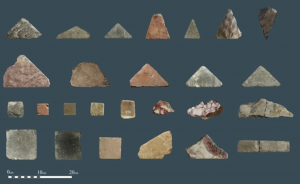
Israeli Archaeologists reconstructed decorative tiles from Second Temple period using the discarded multi-colored tiles with geometric designs that were a gift from Roman Caesar Augustus to King Herod, known to have adorned the Temple compound and surrounding buildings.
By Yori Yalon
Striking in their modernity: Researchers have completed the first-ever reconstruction of archaeological elements from the Second Temple — a number of floor tiles that are believed to have adorned the porticos that surrounded the Temple compound, and possibly other important structures in the area, as well.

From left: Frankie Snyder, who reconstructed the tile designs, Dr. Gabriel Barkay, and Zachi Dvira – Photo: Dudi Vaaknin
The tiles, a gift from the Roman Caesar Augustus to King Herod (who ruled Judea from 37 to 4 BCE), were created using different types of colored stone cut and arranged in clean geometric designs.
The labor of reconstructing the tiles began with the Temple Mount Sifting Project, which has been in operation since 2004 and is devoted to sorting through the rubble that has been removed from the Temple Mount during renovations and construction to recover as many archaeological artifacts as possible.
The project is based at the Emek Tzurim National Park, on the Mount of Olives just outside Jerusalem’s Old City, and is funded by the Ir David Foundation and the Israel Archaeology Foundation. The sifting work turned up fragments of some 600 multicolored floor tiles, nearly 100 of which were positively dated to the Second Temple era based on their size and on similar findings from Herod’s palaces at Masada, Herodium, Jericho, and other sites. The dating process also compared the tiles to other similar flooring details from Italian palaces and villas that date back to the days of Herod.
Most of the marble and other stone used to create the tiles was imported to Judea from Rome, Asia Minor (modern Turkey), Tunisia, and Egypt. The stone was cut into geometric shapes. Recently, project member Frankie Snyder, an expert in Herodian-style flooring with an academic background in mathematics and Judaic Studies, used geometric principles to reconstruct a number of the designs that were used to embellish the Temple courtyard and its surrounding wings.
“We reconstructed seven possible designs of the decorative tiles that adorned the Temple Mount buildings. The designs we’ve reconstructed so far feature combinations of squares, triangles, a star shaped pattern, and a pattern featuring a four-pointed shape,” Snyder said.
“This type of flooring, called ‘opus sectile,’ Latin for ‘cut work,’ is very expensive and was considered to be far more prestigious than mosaic tiled floors. So far, we have succeeded in restoring seven potential designs of the majestic flooring that decorated the buildings of the Temple Mount.
“The tile segments were perfectly inlaid such that one could not even insert a sharp blade between them.”
According to Snyder, there were no cut work tile floors in Jerusalem prior to the reign of King Herod, a fact that also helps date the artifacts.
Archaeologist Zachi Dvira, one of the initiators and managing partners of the Temple Mount Sifting Project, said that researchers until now have not looked into the kinds of flooring that existed on the Temple Mount buildings and in the Temple itself.
Dr. Gabriel Barkay, another co-founder the project, said: “We might not have had the privilege of seeing the Temple in all its glory, but now that these special floor [tiles] have been uncovered, it enables us to get an idea of the Temple’s incredible splendor.”
On Thursday, the tiles will be displayed at the City of David National park at the 17th Annual Archaeological Conference hosted by the Megalim Institute.
View original Israel Hayom publication at:
http://www.israelhayom.com/site/newsletter_article.php?id=36227






 Israeli New Shekel Exchange Rate
Israeli New Shekel Exchange Rate